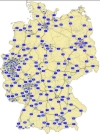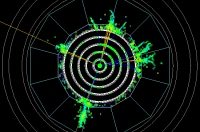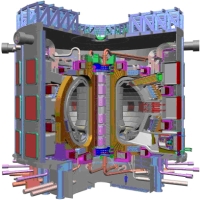Germany goes Tera

Germany, with its famous network of autobahns, now has a new network for particle physics: the Terascale Alliance. |
All German universities and research institutes involved in the LHC and ILC have just pocketed 25 million Euros – and the prospect of a bright future at the Terascale. A DESY-driven funding proposal for the project ‘Helmholtz Alliance: Physics at the Terascale’ was approved by the senate of the Helmholtz Association on Tuesday this week. It bundles resources and expertise in German particle physics to allow scientists to play leading roles in particular in the LHC– and of course also the ILC.
Read more...
-- Barbara Warmbein |
|
 |
Feedback wanted on Detector Concept Report

A simulation of a particle event in the ILC that would enable physicists to determine whether the decays display evidence for the Standard Model Higgs or something else. (Image courtesy of
Norman Graf, SLAC) |
RDR meet your other half. A draft version of the Detector Concept Report for the International Linear Collider is now available online. In February, the Global Design Effort published the draft Reference Design Report, providing the first detailed technical snapshot of the accelerator. The DCR completes the picture and makes the physics and detector case for the ILC.
Read more...
-- Elizabeth Clements |
 |
|
|
 |
From Interactions News Wire
15 May 2007
Johns Hopkins Team Finds Ring of Dark Matter
Using NASA's Hubble Space Telescope, a team of astronomers has
discovered a ghostly ring of dark matter that formed long ago during
a titanic collision between two massive galaxy clusters...
Read more... |
|
From interactions.org
15 May 2007
Boost for Particle Physics in Germany Helmholtz Alliance “Physics at the Terascale” approved today
Read more... |
|
From New York Times
15 May 2007
A Giant Takes On Physics' Biggest Questions
... For the I.L.C., a boring Higgs is better than nothing.
Read more... |
|
From The Boston Globe
12 May 2007
Project signals Europe's bid to dominate particle physics
... An international consortium in February outlined a bold vision for an International Linear Collider, a 20-mile, straight-line accelerator -- more powerful than CERN's -- considered likely to be built in Asia, if it is built.
Read more... |
|
From The Boston Globe
12 May 2007
Scientists hope collider makes a big bang
GENEVA -- In a 17-mile circular tunnel curving beneath the Swiss-French border, scientists are poised to recreate the universe's first trillionth of a second.
Read more... |
|
From The New Yorker
7 May 2007
Crash Course
... Meanwhile, physicists are already lobbying for the next generation of machines. The plan for the International Linear Collider, which, as its name suggests, would be built in a straight line rather than a ring, calls for smashing electrons and positrons together at the midpoint of a tunnel twenty miles long.
Read more... |
|
|
 |
 |
|
|
 |
How to make big international science projects happen

A cutaway view of ITER, a large international project to demonstrate the scientific and technological feasibility of fusion. |
At the annual American Physical Society meeting in Jacksonville, Florida on 14 April 2007, I participated in a special session entitled “How to make big international projects happen.” The speakers were James Van Dam, University of Texas at Austin, presenting ITER, Joe Dehmer, NSF, presenting ideas related to LHC, and me, presenting our approach for the International Linear Collider. The ILC is the baby in the group, just developing the design and without government approvals or funding for the project yet. The LHC is the furthest along, having just completed construction and beginning its commissioning programme. There is much for us to learn from the LHC and we are trying hard to take full advantage through our CERN GDE collaborators. There is also much to be learned from ITER, a different type of international project, and Van Dam’s talk was particularly interesting from that standpoint.
Read more...
-- Barry Barish
Director's Corner Archive |
 |
|
|
 |
|
What is it? (Again)
 Last week, we asked our readers to write us and guess what is featured in
the above image. We did receive some responses, but none of them were
correct. So this week, we are asking you to guess again! (Hint -- It is not related to
calorimetry or the damping rings, but the image comes from Cornell
University.)
Last week, we asked our readers to write us and guess what is featured in
the above image. We did receive some responses, but none of them were
correct. So this week, we are asking you to guess again! (Hint -- It is not related to
calorimetry or the damping rings, but the image comes from Cornell
University.)
|
arXiv preprints
705.1920
14 May 2007
Leptogenesis, Dark Matter and Higgs Phenomenology at TeV
705.1496
10 May 2007
The MSSM with heavy scalars
0705-1290
9 May 2007
Landscape Implications of Extended Higgs Models
705.1259
9 May 2007
Towards a measurement of the two-photon decay width of the Higgs boson at a Photon Collider
EUDET Report
2006-089
A Study of Emittance Measurement at the ILC
|

